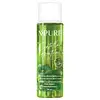What's inside
What's inside
 Key Ingredients
Key Ingredients

 Benefits
Benefits

 Concerns
Concerns

 Ingredients Side-by-side
Ingredients Side-by-side

Water
Skin ConditioningGlycerin
HumectantPropylene Glycol
HumectantNiacinamide
SmoothingCentella Asiatica Extract
CleansingTranexamic Acid
AstringentDipotassium Glycyrrhizate
HumectantGlycyrrhiza Glabra Root Extract
BleachingSalicylic Acid
MaskingCamellia Sinensis Leaf Water
MaskingDMDM Hydantoin
PreservativeAllantoin
Skin ConditioningPEG-40 Hydrogenated Castor Oil
EmulsifyingDisodium EDTA
10-Hydroxydecenoic Acid
Skin ConditioningCitrus Junos Seed Extract
AntioxidantCitrus Unshiu Peel Extract
MaskingActinidia Chinensis Seed Extract
Skin ConditioningFragaria Chiloensis Fruit Extract
Skin ConditioningVitis Vinifera Leaf Extract
Skin ConditioningVitis Vinifera Skin Extract
AntioxidantGarcinia Mangostana Peel Extract
Skin ConditioningParfum
MaskingWater, Glycerin, Propylene Glycol, Niacinamide, Centella Asiatica Extract, Tranexamic Acid, Dipotassium Glycyrrhizate, Glycyrrhiza Glabra Root Extract, Salicylic Acid, Camellia Sinensis Leaf Water, DMDM Hydantoin, Allantoin, PEG-40 Hydrogenated Castor Oil, Disodium EDTA, 10-Hydroxydecenoic Acid, Citrus Junos Seed Extract, Citrus Unshiu Peel Extract, Actinidia Chinensis Seed Extract, Fragaria Chiloensis Fruit Extract, Vitis Vinifera Leaf Extract, Vitis Vinifera Skin Extract, Garcinia Mangostana Peel Extract, Parfum
Water
Skin ConditioningGlycerin
HumectantCellulose
AbsorbentSodium Chloride
MaskingSodium Citrate
BufferingButylene Glycol
HumectantPhenoxyethanol
PreservativeLactobionic Acid
BufferingCitric Acid
BufferingHydroxyacetophenone
AntioxidantPseudoalteromonas Ferment Extract
HumectantSodium Hyaluronate
HumectantPEG-40 Hydrogenated Castor Oil
EmulsifyingDisodium EDTA
Astragalus Membranaceus Root Extract
EmollientAminomethyl Propanol
BufferingSaposhnikovia Divaricata Root Extract
AntimicrobialCalendula Officinalis Flower Extract
MaskingCaprylic/Capric Triglyceride
MaskingIsohexadecane
EmollientSodium Salicylate
PreservativeGastrodia Elata Root Extract
Skin ConditioningAlbizia Julibrissin Flower Extract
Skin ConditioningHamamelis Virginiana Extract
AntiseborrhoeicCedrus Atlantica Bark Oil
MaskingMelaleuca Alternifolia Leaf Oil
AntioxidantCitrus Paradisi Peel Oil
MaskingPelargonium Graveolens Oil
MaskingGlycolic Acid
BufferingQuaternium-73
1,2-Hexanediol
Skin ConditioningMadecassoside
AntioxidantAsiaticoside
AntioxidantAsiatic Acid
Skin ConditioningMadecassic Acid
Skin ConditioningWater, Glycerin, Cellulose, Sodium Chloride, Sodium Citrate, Butylene Glycol, Phenoxyethanol, Lactobionic Acid, Citric Acid, Hydroxyacetophenone, Pseudoalteromonas Ferment Extract, Sodium Hyaluronate, PEG-40 Hydrogenated Castor Oil, Disodium EDTA, Astragalus Membranaceus Root Extract, Aminomethyl Propanol, Saposhnikovia Divaricata Root Extract, Calendula Officinalis Flower Extract, Caprylic/Capric Triglyceride, Isohexadecane, Sodium Salicylate, Gastrodia Elata Root Extract, Albizia Julibrissin Flower Extract, Hamamelis Virginiana Extract, Cedrus Atlantica Bark Oil, Melaleuca Alternifolia Leaf Oil, Citrus Paradisi Peel Oil, Pelargonium Graveolens Oil, Glycolic Acid, Quaternium-73, 1,2-Hexanediol, Madecassoside, Asiaticoside, Asiatic Acid, Madecassic Acid
 Reviews
Reviews

Ingredients Explained
These ingredients are found in both products.
Ingredients higher up in an ingredient list are typically present in a larger amount.
Disodium EDTA plays a role in making products more stable by aiding other preservatives.
It is a chelating agent, meaning it neutralizes metal ions that may be found in a product.
Disodium EDTA is a salt of edetic acid and is found to be safe in cosmetic ingredients.
Learn more about Disodium EDTAGlycerin is already naturally found in your skin. It helps moisturize and protect your skin.
A study from 2016 found glycerin to be more effective as a humectant than AHAs and hyaluronic acid.
As a humectant, it helps the skin stay hydrated by pulling moisture to your skin. The low molecular weight of glycerin allows it to pull moisture into the deeper layers of your skin.
Hydrated skin improves your skin barrier; Your skin barrier helps protect against irritants and bacteria.
Glycerin has also been found to have antimicrobial and antiviral properties. Due to these properties, glycerin is often used in wound and burn treatments.
In cosmetics, glycerin is usually derived from plants such as soybean or palm. However, it can also be sourced from animals, such as tallow or animal fat.
This ingredient is organic, colorless, odorless, and non-toxic.
Glycerin is the name for this ingredient in American English. British English uses Glycerol/Glycerine.
Learn more about GlycerinPeg-40 Hydrogenated Castor Oil is derived from castor oil and polyethylene glycol (PEG). It is used as a emollient and emulsifier.
As an emulsifier, it helps prevent ingredients from separating. It also helps make the other ingredients more soluble; it is often used to solubilize fragrances. This increases spreadability and elongates shelf life in a product.
Emollients help soothe and soften the skin. They do this by creating a protective film on your skin. This barrier helps trap moisture and keeps your skin hydrated. Emollients may be effective at treating dry or itchy skin.
This ingredient may or may not be vegan, depending on the source.
Peg-40 Hydrogenated Castor Oil may not be fungal-acne safe. We recommend speaking with a professional if you have any questions or concerns.
Learn more about PEG-40 Hydrogenated Castor OilWater. It's the most common cosmetic ingredient of all. You'll usually see it at the top of ingredient lists, meaning that it makes up the largest part of the product.
So why is it so popular? Water most often acts as a solvent - this means that it helps dissolve other ingredients into the formulation.
You'll also recognize water as that liquid we all need to stay alive. If you see this, drink a glass of water. Stay hydrated!
Learn more about Water